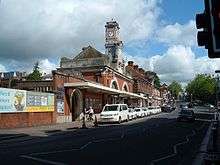Tunbridge Wells railway station
| Tunbridge Wells | |
|---|---|
|
Tunbridge Wells station, western approach | |
| Location | |
| Place | Royal Tunbridge Wells |
| Local authority | Tunbridge Wells |
| Grid reference | TQ584392 |
| Operations | |
| Station code | TBW |
| Managed by | Southeastern |
| Number of platforms | 2 |
| DfT category | C1 |
|
Live arrivals/departures, station information and onward connections from National Rail Enquiries | |
| Annual rail passenger usage* | |
| 2004/05 |
|
| 2005/06 |
|
| 2006/07 |
|
| 2007/08 |
|
| 2008/09 |
|
| 2009/10 |
|
| 2010/11 |
|
| 2011/12 |
|
| 2012/13 |
|
| 2013/14 |
|
| 2014/15 |
|
| History | |
| 20 September 1845 | first station opened[1] |
| 25 November 1846 | present station opened |
| National Rail – UK railway stations | |
| * Annual estimated passenger usage based on sales of tickets in stated financial year(s) which end or originate at Tunbridge Wells from Office of Rail and Road statistics. Methodology may vary year on year. | |
|
| |


Tunbridge Wells railway station serves Royal Tunbridge Wells in Kent, England. The station and all trains serving it are currently operated by Southeastern. It is located directly on the double-tracked electrified Hastings Line.
The station is located in an open cut with tunnels at both ends of the station. The station has entrances on both sides. The ticket office and platform 1 can be accessed directly from street level on the west side of the station or by a footbridge from the east side; platform 2 is accessible from the street (Mount Pleasant Road) or footbridge by stairs and a staff-operated lift. Both platforms are signalled for reversible working and trains arrive/depart at either platform in either direction.
Just beyond Grove Tunnel at the south end of the station was Grove Junction, where trains took the single line branch to Tunbridge Wells West. The branch closed on 6 July 1985. Ticket barriers are now in operation.
History
The first station was a temporary terminus opened on 20 September 1845 situated north of Wells Tunnel. This closed when the line was extended to the present station which opened on 25 November 1846. It became a through station in 1851 when the line opened to Robertsbridge and a year later opened through to Hastings. The LBSCR line from Grove Junction to Tunbridge Wells(West) opened in 1867 for goods and 1876 for passenger. Immediately after becoming part of the Southern Railway in 1923 the station was named Tunbridge Wells Central. In 1985 preparation for electrification the platforms were rebuilt and the tracks were resignalled. Electric trains started running in 1986. The station again became just Tunbridge Wells.
Services
As of 12 January 2015 the typical off-peak service from the station is:
- 2 tph (trains per hour) to London Charing Cross (fast service - not calling at London Bridge until August 2016)
- 2 tph (trains per hour) to London Cannon Street (semi-fast service calling at London Bridge)
- 2 tph to Hastings (1 stopping, 1 semi-fast)[2]
| Preceding station | |
Following station | ||
|---|---|---|---|---|
| High Brooms | Southeastern Hastings Line semi-fast |
Wadhurst | ||
| Southeastern Hastings Line slow |
Frant | |||
| Southeastern Cannon Street to Tunbridge Wells |
Terminus | |||
| Disused railways | ||||
| High Brooms Line and station open |
British Rail Southern Region Cuckoo Line |
Tunbridge Wells West Line and station closed | ||
| Terminus | British Rail Southern Region Tunbridge Wells Central to Three Bridges line |
Tunbridge Wells West Line and station closed | ||
References
- ↑ Southern Region Record by R.H.Clark
- ↑ Network Rail Timetable May 2010: Table 206
External links
| Wikimedia Commons has media related to Tunbridge Wells railway station. |
- Train times and station information for Tunbridge Wells railway station from National Rail
Coordinates: 51°07′48″N 0°15′47″E / 51.130°N 0.263°E
